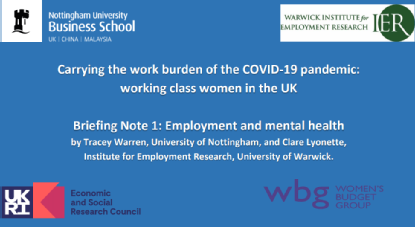First results from new study examining the impact of COVID-19 on working-class women in the UK published today
 Working class women have borne the brunt of the cuts to working hours as employers struggle to ride out the pandemic, according to new findings published today.
Working class women have borne the brunt of the cuts to working hours as employers struggle to ride out the pandemic, according to new findings published today.
43 per cent of working class women did no hours of work in April compared to just 20 per cent of women in professional or managerial roles. By June fewer than half of all women in work (48 per cent) were still working full-time hours.
Professor Tracey Warren (University of Nottingham) and Professor Clare Lyonette (IER, University of Warwick) are working with the Women’s Budget Group to understand how working-class women are responding in real-time to the pressures imposed by the virus.
Today’s briefing paper – Carrying the work burden of the COVID-19 pandemic: working class women in the UK: Employment and Mental Health – focuses on patterns of employment and mental health in the first three months of lockdown, using data from the monthly Understanding Society COVID-19 UK survey, and explores to what extent the experience of working class women differs from middle class women and from men.
The first wave of results reveals that many more working class women than men or women in middle class jobs saw their hours cut to zero in the first months of lockdown, with potentially severe financial consequences.
Those working class women still at work are far less likely to be working from the relative safety of home than women in managerial or professional roles – 80 per cent of working class women said they were “never” working from home in June.
Working class women are also the most likely to be keyworkers in roles with close contact with customers, clients and patients – with greater potential to be exposed to the virus.
Professor Warren said: “Our research shows that working-class women are disproportionately furloughed compared to men and other women - and if they are working, there is a greater potential for women to be exposed to health risks due to the nature of their roles as key workers. We know these women also care for children and relatives, so with the added stress of worrying about if they were to contract coronavirus or how their household will cope with the loss of 20% of their salary due to furlough, it is no wonder their mental health is suffering.” 40 per cent of working class women reported psychological distress in April, higher than other women and men.
Professor Lyonette added: “Although the high levels of psychological distress among working class women have dropped slightly since restrictions were lifted, they are still much higher than before the pandemic. Many working class areas are included in the higher tier groups of the government's 3-tier system of restrictions in England. The effects of any future lockdowns, either local or national, could be far-reaching and extremely damaging for working class women who provide vital work, both paid and unpaid”.
Dr Mary-Ann Stephenson, Director of the Women’s Budget Group, said: “Working class women have been more likely to be furloughed and are at high risk of redundancy as the furlough scheme is rolled back. The Government's national replacement scheme creates little incentives for employers to keep these women on. Low paid women in areas where lock down is being re-imposed will be entitled to additional help if they are in a closed down sector, but for workers on the minimum wage or just above, two thirds of current earnings is likely to mean poverty. At the same time the increase in universal credit introduced at the start of lockdown is due to end in March so low paid workers and those who lose their jobs will be worse off. If the Government is serious about building back better, it needs to take urgent action to protect the employment and incomes of working class women.”
